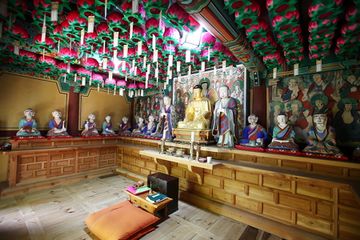"나주 다보사 목조석가여래삼존상 및 소조십육나한좌상"의 두 판 사이의 차이
Mkichukova (토론 | 기여) (→영문) |
(→영문) |
||
| 34번째 줄: | 34번째 줄: | ||
'''Wooden Sakyamuni Buddha Triad and Clay Seated Sixteen Arhats of Dabosa Temple, Naju''' | '''Wooden Sakyamuni Buddha Triad and Clay Seated Sixteen Arhats of Dabosa Temple, Naju''' | ||
| − | + | These 19 statues enshrined in Yeongsanjeon Hall were made in 1625 by the sculptor-monk Suyeon and his colleagues to depict Sakyamuni Buddha and his disciples. Originally, the set was made to be enshrined in Ssanggyesa Temple in Naju, and it is unknown when they were moved to Dabosa Temple. | |
| − | Sakyamuni Buddha | + | The triad at the center of the altar consists of Sakyamuni, the historical Buddha who lived in ancient India, in the middle flanked by Ananda and Maha Kasyapa, his two best disciples. To either side of the altar are statues of the 16 arhats, who are the perfected disciples of the Buddha. The realistic depictions and natural positions are characteristic of Suyeon's work at his prime. |
| − | + | Inside several of the statues were written vows with detailed records about the purpose, period, creators, patrons, and '''initiators''' of the statue, which are valuable in the study of Joseon-period Buddhist sculpture. | |
*We have mainly been translating 제작자, 시주자, 발원자 as "those who", "people who", but it is necessary to come up with a suitable noun in English due to the structure of Korean sentences | *We have mainly been translating 제작자, 시주자, 발원자 as "those who", "people who", but it is necessary to come up with a suitable noun in English due to the structure of Korean sentences | ||
2020년 11월 20일 (금) 18:48 판
| 나주 다보사 목조석가여래삼존상 및 소조십육나한좌상 Wooden Sakyamuni Buddha Triad and Clay Seated Sixteen Arhats of Dabosa Temple, Naju |
|
 나주 다보사 목조석가여래삼존상 및 소조십육나한좌상, 국가문화유산포털, 문화재청. |
|
| 대표명칭 | 나주 다보사 목조석가여래삼존상 및 소조십육나한좌상 |
|---|---|
| 영문명칭 | Wooden Sakyamuni Buddha Triad and Clay Seated Sixteen Arhats of Dabosa Temple, Naju |
| 한자 | 羅州 多寶寺 木造 釋迦如來 三尊像 및 塑造 十六羅漢 坐像 |
| 주소 | 전라남도 나주시 금성산길 83, 다보사 (경현동) |
| 지정번호 | 보물 제1834호 |
| 지정일 | 2014년 9월 19일 |
| 분류 | 유물/불교조각/목조/불상 |
| 시대 | 조선시대 |
| 수량/면적 | 19구, 복장유물 일괄(발원문류 9점, 후령통 14점, 오보병 2점) |
| 웹사이트 | 나주 다보사 목조석가여래삼존상 및 소조십육나한좌상, 국가문화유산포털, 문화재청. |
|
|
|
해설문
국문
다보사 목조 석가여래 삼존상과 소조 십육 나한 좌상은 17세기 전반에 전국을 무대로 활동한 대표적인 조각승 수연과 그의 동료들이 만든 불상이다.
이 불상들은 조선 후기 불교 미술의 특징인 평범하면서 담백한 아름다움과 중량감 있는 형태미를 잘 간직하고 있다. 조각승 수연의 전성기 때의 조각 경향이 잘 드러나 있는 불상이다.
여러 존상에서 1625년에 작성한 발원문(發願文)*이 나왔는데, 여기에는 조성 목적, 조성 시기와 제작자, 시주자와 발원자 등 조성과 관련한 구체적인 기록이 남아 있다. 이 발원문은 이 시기 불교 조각을 연구하는 데에 귀중한 자료이다.
- 발원문(發願文): 신이나 부처에게 소원을 비는 내용을 적은 글.
영문
Wooden Sakyamuni Buddha Triad and Clay Seated Sixteen Arhats of Dabosa Temple, Naju
These 19 statues enshrined in Yeongsanjeon Hall were made in 1625 by the sculptor-monk Suyeon and his colleagues to depict Sakyamuni Buddha and his disciples. Originally, the set was made to be enshrined in Ssanggyesa Temple in Naju, and it is unknown when they were moved to Dabosa Temple.
The triad at the center of the altar consists of Sakyamuni, the historical Buddha who lived in ancient India, in the middle flanked by Ananda and Maha Kasyapa, his two best disciples. To either side of the altar are statues of the 16 arhats, who are the perfected disciples of the Buddha. The realistic depictions and natural positions are characteristic of Suyeon's work at his prime.
Inside several of the statues were written vows with detailed records about the purpose, period, creators, patrons, and initiators of the statue, which are valuable in the study of Joseon-period Buddhist sculpture.
- We have mainly been translating 제작자, 시주자, 발원자 as "those who", "people who", but it is necessary to come up with a suitable noun in English due to the structure of Korean sentences
영문 해설 내용
영산전에 모셔진 석가여래삼존상과 십육나한상은 1625년 승려 조각가 수연과 그의 동료들이 만들었다. 원래 나주 쌍계사에 모시기 위해 만들었으며, 언제 다보사로 옮겼는지는 알 수 없다.
불단 중앙에는 석가여래가 앉아 있고, 양옆에는 부처의 여러 제자 중 으뜸이라고 하는 아난과 가섭이 서 있다. 나한상 16구는 불단 양옆에 배치되어 있다. 사실적인 묘사, 자연스러운 자세 등 수연의 전성기 때 작품 경향이 잘 드러난다.
여러 불상의 내부에서 발견된 발원문에 조성 목적, 시기, 제작자, 시주자, 발원자 등에 대한 구체적인 기록이 남아 있어, 조선시대 불교 조각을 연구하는 데 귀중한 자료가 된다.